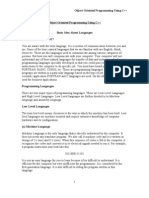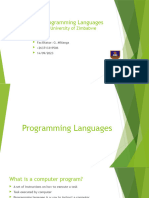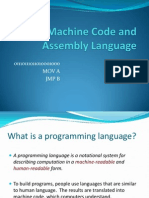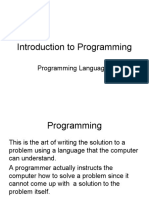Explain The Programming Language Generations
Uploaded by
Arnold NdukuyuExplain The Programming Language Generations
Uploaded by
Arnold NdukuyuExplain the Programming Language Generations
First Generation
The first generation program language is pure machine code included only ones and zeros. Programmers
had to write their code by hand then transfer it to a computer via a punch tape, punch card or flicking
switches. There is no need to translate the code and it will run straight away. Below are its advantages
and disadvantages:
Advantages
It was fast and efficient
Code can make use of particular processor features e.g. special registers
Disadvantages
Code is not portable
Appending the code is a tedious process.
Second Generation
It is otherwise known as Assembly code. Its lines of code resemble English, making programming easier.
Use of mnemonic codes such as LDA for load and STA for store means the code is easier to read and
write. An assembler is used to convert the assembly code into object code or machine code which can
be directly understood by the computer.
Advantages
Code can be fast and efficient
Code can make use of specific processor features such as special registers
It is easier to read and write when compared to machine code
Disadvantages
Not portable – machine dependent
Third Generation (High Level Language)
Third-generation programming languages brought about a lot of programmer-friendly features, for
example, iterations, conditionals and classes. Third generation languages are imperative, meaning that
code is executed line by line, in sequence. Converting a 3rd generation program into object code
requires a Compiler or an Interpreter.
A single line of third generation code can sum up several lines of object (machine) code, making coding
fast and also saving time.
Advantages
Machine independence, can be easily ported to other computers.
Programmer friendly, and saves time as one line of 3rd gen is equal to many lines of 1st and 2nd
gen languages
Disadvantages
Limited functionality of certain processor specific functions.
Fourth Generation
Fourth-generation languages are designed to cut down on the programming work and the time needed
to develop software. This also results in a reduction in the cost of software development. Fourth gen
languages are developed for a specific purpose such as; to query databases (SQL), languages to make
reports (Oracle Reports) and languages to construct user interface (XUL).
You might also like
- 4.2 High and Low Level Languages IGCSE CS.docxNo ratings yet4.2 High and Low Level Languages IGCSE CS.docx14 pages
- Chapter 1-Introduction To Computer Programming100% (1)Chapter 1-Introduction To Computer Programming26 pages
- Programming LAnguages & Techniques (NTA 5) Lecture 1No ratings yetProgramming LAnguages & Techniques (NTA 5) Lecture 135 pages
- Types of Programming Languages: 1. Low Level LanguageNo ratings yetTypes of Programming Languages: 1. Low Level Language14 pages
- Part 03 - Lesson 1 Introduction To Computer (Cont.)No ratings yetPart 03 - Lesson 1 Introduction To Computer (Cont.)7 pages
- 18 Advantages of High-Level Languages: 1. Program Development Is Faster in A High-Level LanguageNo ratings yet18 Advantages of High-Level Languages: 1. Program Development Is Faster in A High-Level Language5 pages
- Programming Language Generations Handout trialNo ratings yetProgramming Language Generations Handout trial7 pages
- Introduction-Elementary Programming Principles Elementary Programming PrinciplesNo ratings yetIntroduction-Elementary Programming Principles Elementary Programming Principles38 pages
- Programming Languages A Set of Words Symbols and Codes Used To Write A Program Is Called Programming Language Two Types of Programming Languages Low Level Languages High Level Languages100% (1)Programming Languages A Set of Words Symbols and Codes Used To Write A Program Is Called Programming Language Two Types of Programming Languages Low Level Languages High Level Languages39 pages
- UNIT 1 Introduction to Structured ProgrammingNo ratings yetUNIT 1 Introduction to Structured Programming21 pages
- Embedded Systems: Embedded C Introduction To Embedded CNo ratings yetEmbedded Systems: Embedded C Introduction To Embedded C6 pages
- Introduction To Assembly Language ProgrammingNo ratings yetIntroduction To Assembly Language Programming10 pages
- Dokumen - Tips - Program Language Generations and Programming Geofizoktatokvasssome Basic ConceptsNo ratings yetDokumen - Tips - Program Language Generations and Programming Geofizoktatokvasssome Basic Concepts26 pages
- Programming Language Instruction Set Architecture Machine LanguageNo ratings yetProgramming Language Instruction Set Architecture Machine Language9 pages
- C Programming: C Programming Language for beginners, teaching you how to learn to code in C fast!From EverandC Programming: C Programming Language for beginners, teaching you how to learn to code in C fast!No ratings yet
- Fundamentals of Ict: I. Ii. Iii. Iv. v. VINo ratings yetFundamentals of Ict: I. Ii. Iii. Iv. v. VI16 pages


































































